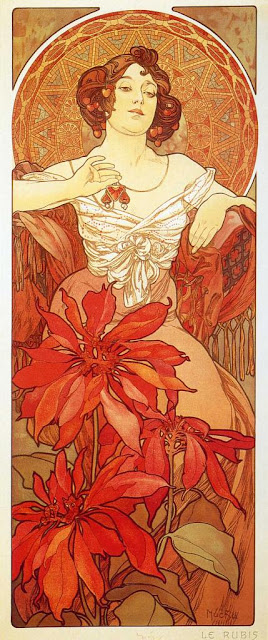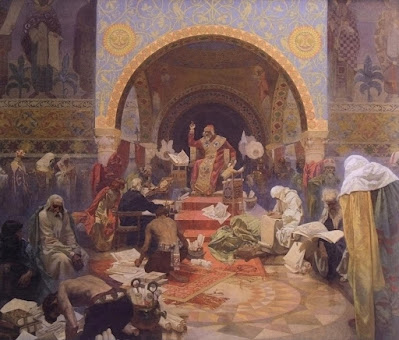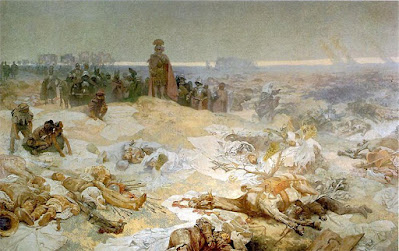Alphonse showed an early talent for drawing; a local merchant impressed by his work gave him a gift of paper, at the time a luxury item.] In the preschool period, he drew exclusively with his left hand. He had a talent for music: he was an alto singer and violin player. After completing Volksschule, he wanted to continue with his studies, but his family was not able to fund them, as they were already funding the studies of his three step-siblings.
His music teacher sent him to Pavel Křížkovský, choirmaster of St Thomas's Abbey in Brno, to be admitted to the choir and to have his studies funded by the monastery. Křížovský was impressed by his talent, but he was not able to admit and fund him, as he had just admitted another talented young musician, Leoš Janáček.[
Křížovský sent him to a choirmaster of the Cathedral of St. Peter and Paul,[ who admitted him as a chorister and funded his studies at the gymnasium in Brno, where he received his secondary school education.[10] After his voice broke, he gave up his chorister position, but played as a violinist during masses. WIKIPEDIA
He became devoutly religious, and wrote later, "For me, the notions of painting, going to church, and music are so closely knit that often I cannot decide whether I like church for its music, or music for its place in the mystery which it accompanies." He grew up in an environment of intense Czech nationalism in all the arts, from music to literature and painting. He designed flyers and posters for patriotic rallies.
His singing abilities allowed him to continue his musical education at the Gymnázium Brno in the Moravian capital of Brno, but his true ambition was to become an artist. He found some employment designing theatrical scenery and other decorations. In 1878 he applied to the Academy of Fine Arts in Prague, but was rejected and advised to "find a different career". In 1880, at the age of 19, he traveled to Vienna, the political and cultural capital of the Empire, and found employment as an apprentice scenery painter for a company which made sets for Vienna theaters. While in Vienna, he discovered the museums, churches, palaces and especially theaters, for which he received free tickets from his employer.He also discovered Hans Makart, a very prominent academic painter, who created murals for many of the palaces and government buildings in Vienna, and was a master of portraits and historical paintings in grand format. His style turned Mucha in that artistic direction and influenced his later work. He began experimenting with photography, which became an important tool in his later work.
To his misfortune, a terrible fire in 1881 destroyed the Ringtheater, the major client of his firm. Later in 1881, almost without funds, he took a train as far north as his money would take him. He arrived in Mikulov in southern Moravia, and began making portraits, decorative art and lettering for tombstones. His work was appreciated, and he was commissioned by Count Eduard Khuen Belasi, a local landlord and nobleman, to paint a series of murals for his residence at Emmahof Castle, and then at his ancestral home in the Tyrol, Gandegg Castle. The paintings at Emmahof were destroyed by fire in 1948, but his early versions in small format exist (now on display at the museum in Brno). He showed his skill at mythological themes, the female form, and lush vegetal decoration. Belasi, who was also an amateur painter, took Mucha on expeditions to see art in Venice, Florence and Milan, and introduced him to many artists, including the famous Bavarian romantic painter, Wilhelm Kray, who lived in Munich.WIKIPEDIA

















































.jpg)












Keine Kommentare:
Kommentar veröffentlichen